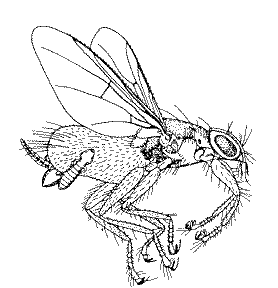
|
Phoretic relationships between lice and Hippoboscid flies
Despite belonging to a group of winged insects, lice have secondarily lost their wings in favour of a more passive form of transmission from host to host. Most lice are transmitted by physical contact with mates during breeding to ensure that the lice remaining on a suitable host species. Thus its been said that lice are passed from one host generation to the next like genetic heirlooms. However, a number of alternative possible mechanisms for transmission exist, and perhaps the most famous of these involves the louse-fly (Hippoboscidae). These flies are frequently found around many birds and there are a number of reports of lice found attached to them, particularly after the death of the host. This behavior by the lice is known as phoresy and is in effect a risky process of redistribution in which the lice get to travel freely on the flies without feeding on them. There are many records of lice found attached to Hippoboscid flies, although in almost all instances the lice concerned are members of the suborder Ischnocera. This type of transmission allows the louse to escape a dead or dying host in an attempt to find a more favourable host environment. Nevertheless, there is a high element of risk in the process as the flies are not specific to particular host species and are likely to carry the lice to an unsuitable host on which they will be unable to establish. This type of behaviour is important when studying the cospeciation of lice and their hosts as it could provide an explanation for some of the instances in which lice have switched from one host species to another during their coevolutionary history.
Title Illustration
Two feather lice attached to the abdomen of a louse-fly.
Drawing from Rothschild, M. and Clay, T. (1952). Fleas, flukes & Cuckoos:
A study of bird ectoparasites. Colins (New Naturalist Series), London).
Drawing copyright © 1952, Colins Publishers.



 Go to quick links
Go to quick search
Go to navigation for this section of the ToL site
Go to detailed links for the ToL site
Go to quick links
Go to quick search
Go to navigation for this section of the ToL site
Go to detailed links for the ToL site